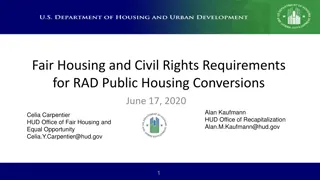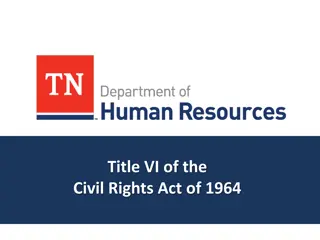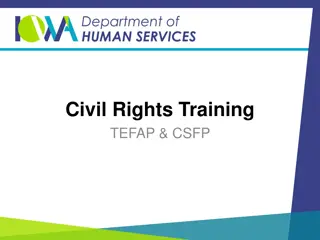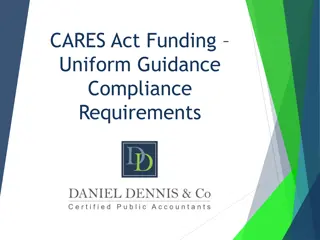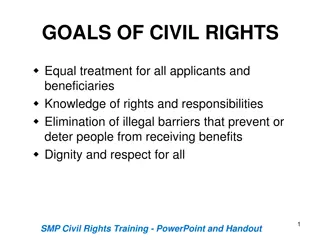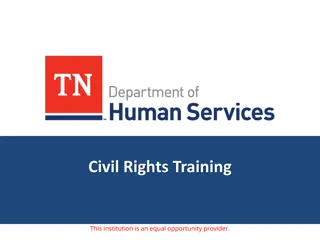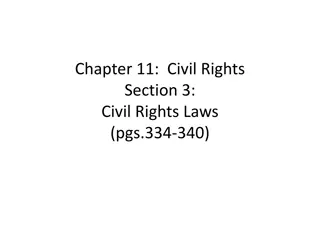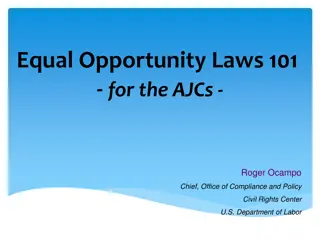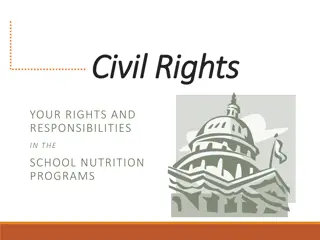Civil Rights Obligations in Federal Funding Programs
Federal funding programs require adherence to civil rights obligations, as enforced by the Office for Civil Rights. This includes upholding non-discrimination laws such as Title VI of the Civil Rights Act of 1964, the Omnibus Crime Control and Safe Streets Act of 1968, Section 504 of the Rehabilitation Act of 1973, among others. These laws ensure equal access and prevent discrimination based on race, color, national origin, disability, age, and gender in federally funded programs and activities.
Download Presentation

Please find below an Image/Link to download the presentation.
The content on the website is provided AS IS for your information and personal use only. It may not be sold, licensed, or shared on other websites without obtaining consent from the author.If you encounter any issues during the download, it is possible that the publisher has removed the file from their server.
You are allowed to download the files provided on this website for personal or commercial use, subject to the condition that they are used lawfully. All files are the property of their respective owners.
The content on the website is provided AS IS for your information and personal use only. It may not be sold, licensed, or shared on other websites without obtaining consent from the author.
E N D
Presentation Transcript
U.S. Department of Justice Office of Justice Programs Office for Civil Rights AS PRESENTED BY: The Minnesota Department of Public Safety Office of Justice Programs April 17, 2019
One Simple Concept Civil Rights Obligations Whenever Federal funds are involved, there are civil rights requirements that follow
The Office for Civil Rights Enforces: Title VI of the Civil Rights Act of 1964 The Omnibus Crime Control & Safe Streets Act of 1968 Section 504 of the Rehabilitation Act of 1973 Title II of the Americans with Disabilities Act of 1990 Age Discrimination Act of 1975 Title IX of the Education Amendments of 1972 Section 1407 of the Victims of Crime Act (VOCA) Juvenile Justice and Delinquency Prevention Act (JJDPA) of 1974 Violence Against Women Act (VAWA) of 1994
Title VI, Civil Rights Act of 1964 No Person in the United States shall, on the ground of race, color, or national origin, be excluded from participation in, be denied the benefits of, or be subjected to discrimination under any program or activity receiving Federal financial assistance.
Title VI, Civil Rights Act of 1964 To Whom do the Provisions Apply? Generally, the entire department or office within a state or local government is identified as the program or activity. Example: If a project of a county fire department receives Federal funds, the entire fire department is covered, but not the other departments in the county.
Title VI, Civil Rights Act of 1964 Title VI Regulations Prohibit: Providing different services to individuals Denying the opportunity to participate as a member of planning or advisory body Selecting the location of a facility with the purpose or effect of excluding individuals
Omnibus Crime Control and Safe Streets Act of 1968 No person in any state shall, on the ground of race, color, religion, national origin, or sex, be excluded from participation in, be denied the benefits of, or be subjected to discrimination under or be denied employment in connection with any programs or activity funded in whole or in part with funds made available under this chapter.
Victims of Crime Act of 1984 Nondiscrimination Provision No person shall on the ground of race, color, religion, national origin, handicap, or sex be excluded from participation in, denied the benefits of, subjected to discrimination under, or denied employment in connection with, any undertaking funded in whole or in part with sums made available under this subchapter. 34 U.S.C. 20110(e)
VAWA Reauthorization Act of 2013 No person in the United States shall, on the basis of actual or perceived race, color, religion, national origin, sex, gender identity (as defined in paragraph 249(c)(4) of title 18, United States Code), sexual orientation, or disability, be excluded from participation in, be denied the benefits of, or be subjected to discrimination under any program or activity funded in whole or in part with funds made available under [VAWA], and any other program or activity funded in whole or in part with funds appropriated for grants, cooperative agreements, and other assistance administered by the Office on Violence Against Women.
VAWA Reauthorization Act of 2013 (continued) If sex segregation or sex-specific programming is necessary to the essential operation of a program, nothing in this paragraph shall prevent any such program or activity from consideration of an individual s sex. In such circumstances, grantees may meet the requirements of this paragraph by providing comparable services to individuals who cannot be provided with the sex-segregated or sex- specific programming. 34 U.S.C. 12291(b)(13) OCR has posted FAQs on the VAWA nondiscrimination provision .
VAWA Reauthorization Act of 2013 (continued) Sex-Segregated Programming- o When males and females receive services in separate settings Sex-Specific Programming- o When a recipient designs programming differently for males and females Beneficiaries choose the appropriate program based upon gender identity
VAWA Reauthorization Act of 2013 (continued) Necessary to the Essential Operation of a Program Fact-specific inquiry, consider: o Nature of the service o Consequences to beneficiaries of making sex-segregated or sex-specific o Literature on efficacy o Impact on transgender clients Reasons may not be trivial, based solely on convenience, or rooted in stereotypes
VAWA Reauthorization Act of 2013 (continued) Comparable Services- Fact-specific inquiry, consider: Nature, quality, and duration of the services Relative benefits of different therapeutic modalities Geographic location
VAWA Reauthorization Act of 2013 (continued) What is Gender Identity? Actual or perceived gender-related characteristics (from Matthew Shepard - James Bird Hate Crimes Prevention Act) A person s internal view of the individual s gender May or may not correspond to sex assigned at birth Transgender, male, and female are examples of gender identities
VAWA Reauthorization Act of 2013 (continued) Serving Transgender Clients- Assign clients to service which corresponds to the gender with which the client identifies Consider transgender victim s health and safety in making housing assignments Transgender client s own views regarding personal safety deserve serious consideration Do not isolate or segregate Do not make burdensome demands for identity documents Do not inquire into surgery or other medical interventions
Protected Classes National Origin Race Color Religion Sex Disability Gender Identity* Sexual Orientation* Age *- These are only protected for VAWA recipients
Race American Indian or Alaskan Native Native Hawaiian or Other Pacific Islander Black or African American Asian White Hispanic / Latino: Is not a race, it is an ethnicity
Color Discrimination Preference for or aversion to persons of different skin colors, regardless of whether the actor is in the same racial or national origin group
National Origin Ancestor s Place of Origin Physical Characteristics Cultural Characteristics Language Characteristics
What is a Religion? All aspects of religious observance, practice, and belief are protected Christianity Paganism Atheism Any Sincerely - Held Belief Judaism Islam Buddhism Mormonism
Who is in the Disability Class? Individuals who have, have a record of having, or are regarded as having a physical or mental impairment which substantially limits one or more major life activities.
What is a Major Life Activity? These are activities that an average person can perform with little or no difficulty, such as: Sitting Caring for oneself Working Performing manual tasks Standing Lifting Reading Eating Walking Breathing Seeing Hearing Speaking Learning
Disability Definitions Mental Impairment: includes any mental or psychological disorder, such as mental retardation, organic brain syndrome, emotional or mental illness, and specific learning disabilities.
Disability Definitions Physical Impairments: any physiological disorder or condition, cosmetic disfigurement, or anatomical loss affecting one or more of the following systems: Neurological Musculoskeletal Special Sense Organs Respiratory Speech Organs Cardiovascular Reproductive Digestive Genito-Urinary Hemic Lymphatic Skin Endocrine
Disability Definitions Substantially Limits: means the individual must be unable to perform, or be significantly limited in the ability to perform an activity compared to an average person in the general population. Courts have looked at three factors in determining whether someone is substantially limited: Extent: its nature and severity 1. 2. Duration: How long it will last or is expected to last 3. Impact: Its long term impact or expected impact
Disability Definitions Exclusions: A person who currently uses illegal drugs is not protected by the ADA Homosexuality and bisexuality are not impairments and are therefore not disabilities covered by the ADA
Age Discrimination Act of 1975 Prohibits Federally funded organizations from discriminating against persons of any age in its programs and activities Does not cover discrimination in employment EEOC enforces the Age Discrimination in Employment Act, which prohibits employment discrimination against persons over the age of 40
Employment Discrimination Five Forms of Employment Discrimination: Disparate Treatment 1. 2. Adverse Impact 3. Harassment 4. Failure to Accommodate 5. Retaliation
Disparate Treatment Consists of intentional discrimination where an employer deliberately takes an adverse action against an employee based on: Race Color National origin Sex Religion Disability
How Do You Prove Intentional Discrimination? Direct Evidence Indirect Evidence, such as: o Similarly situated people of a different class were treated differently than the complainant o Evidence of bias o False explanation for the differential treatment o Statistical evidence
What is Adverse Impact? Adverse Impact occurs when an employer has a neutral policy or practice which has the effect of excluding employees of a particular race, color, sex, national origin, religion, or disability.
Adverse Impact Examples The following are examples of employment policies which have been found to cause an adverse impact: Minimum height requirements 1. 2. Certain educational requirements 3. Physical agility tests 4. No beard policies
Adverse Impact Evidence of Adverse Impact- The Four-Fifths Rule: When a policy or procedure has a selection rate for any protected class that is less than 4/5ths (80%) of the rate for the group with the highest rate of selection If a Policy has an Adverse Impact- Choose an alternative with less adverse impact The policy or practice may still be used if job related and consistent with business necessity
What is Harassment? Harassment is behavior which creates a hostile work environment for individuals because of their race, sex, color, national origin, religion, or disability
What is Harassment? Comments Innuendo Touching Behavior Jokes Slurs Gestures Pictures Graffiti
What Makes a Work Environment Hostile? A stray remark is not enough to constitute a hostile work environment The harassment must be sufficiently severe or pervasive to alter the terms and conditions of employment
Determining Severity or Pervasiveness Six Factors Use a reasonable person standard to determine the following: Was the conduct verbal or physical or both? 2. How Frequently was the conduct repeated? 3. Was the conduct hostile or merely offensive 4. Was the harasser a co-worker or supervisor? 5. Did others join in the harassment? 6. Was the harassment directed at more than one individual? 1.
What Can an Employer Do About Unlawful Harassment? Take Preventative Action Develop an explicit policy regarding harassment Regularly train all employees Develop effective sanctions Develop a complaint procedure designed to: Protect victims and witnesses against retaliation Encourage complaints Ensure confidentiality
What Can an Employer Do About Unlawful Harassment? Take Remedial Action Promptly and thoroughly investigate all complaints of harassment Take immediate action and appropriate corrective action reflecting the severity of the conduct Restore lost employment benefits or opportunities Discipline the offending employee or supervisor Follow up with the victim to ensure there has been no retaliation
Accommodation: Religion & Disability An employer must make a reasonable accommodation to the known physical or mental limitations of a qualified applicant or employee with a disability An employer must make a reasonable accommodation to the known religious beliefs or practices of an applicant or employee
Protection for Employees Retaliation against an employee for opposing an unlawful employment practice or participating in an investigation, proceeding, or hearing under the following statutes is prohibited: Title VI of the Civil Rights Act The Americans With Disabilities Act The Omnibus Crime Control and Safe Streets Act Title IX of the Education Amendments The Rehabilitation Act The Age Discrimination Act
Protection for Employees As long as an employee had a reasonable and good faith belief that the employer s conduct was illegal, even if the employee turns out to be wrong, the employee is protected However, if the way the individual chooses to protest perceived discrimination is unreasonable or if the opposition is false and malicious, the anti-retaliation provisions will not apply
Discrimination in Delivery of Services Whenever a service is provided, there are potential beneficiaries, and those beneficiaries must be treated equally regardless of race, sex, national origin, age, color, disability, or religion Think of a program in which you are involved that receives federal funding: o Who are the potential beneficiaries? o What are the potential civil rights issues?
Civil Rights Laws & American Indians: An Important Distinction Beneficiary Recipient American Indians, as employees or as beneficiaries of a non- Tribal organization receiving Federal financial assistance are protected by Federal Civil Rights Laws. When Tribes receive Federal financial assistance, they are not subject to the enforcement of Federal Civil Rights Laws when they function as an employer; tribes may be responsible as a provider of services.
Civil Rights Laws & American Indians The following protected classes are of particular importance for American Indians and Alaska Natives: Race National Origin Religion
Civil Rights Laws & American Indians Definition of American Indian for Civil Rights protections: An employee would be entitled to protection of Title VII against employment discrimination regardless of his percentage of Native American ancestry if the employer reasonably believed that the employee was a member of a protected class based on some objective evidence, which may consist of physical appearance, language, cultural activities, or associations. One does not have to prove bloodlines or show tribal membership to be eligible for protection under Federal Civil Rights Laws.
Civil Rights Laws & American Indians Discrimination in employment on the basis of membership in a particular Indian tribe (e.g. favoring members of the Navajo Tribe over members of the Hopi Tribe) constitutes national origin discrimination in violation of Title VII
States & American Indians A State may be discriminating against American Indians if the State has implemented a policy of denying funding to Tribes, based on Tribes having received or having direct access to Federal Financial Assistance The Safe Streets Act contains a State liability waiver in regard to Indian Tribes States do not need to require Indian Tribes to waive sovereign immunity to qualify as subgrantees
Limited English Proficiency A Limited English Proficient (LEP) person has a first language other than English and a limited ability to read, speak, or understand English. National Origin Discrimination includes discrimination on the basis of LEP Recipients of Federal financial assistance have an obligation to reduce language barriers that can preclude meaningful access by LEP persons to important benefits, rights, programs, information and services.



